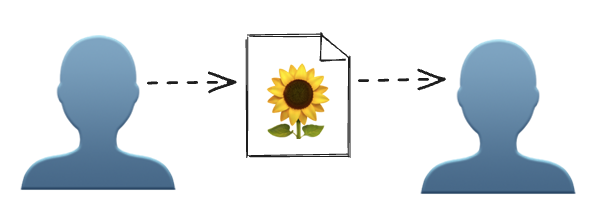Understanding#

Fig. 5 We transfer understanding of software projects in the form of documentation artifacts.#
Shared understanding forms the heartbeat of any successful software project. Peter Naur, in his work “Programming as Theory Building” (1985), emphasized that programming is fundamentally about building a shared theory of the project among all contributors GLU1. Understanding encompasses not only the technical aspects of software, but also the collaborative and ethical dimensions that ensure a software project’s growth and sustainability. Just as a gardener must understand the needs of each plant to cultivate a thriving garden, contributors to a project must grasp its goals, structure, and community standards to foster a productive and harmonious environment. Documentation, of which there are many different forms that we describe below, cultivates a shared understanding of a software project.
Project documentation#
Common documentation files like README’s, CONTRIBUTING guides, and LICENSE files are only a start towards more specific project information.
Comprehensive project documentation is akin to a detailed gardener’s notebook for a well-maintained project, illustrating how the project may be used and the guiding philosophy.
This includes in-depth explanations of the project’s architecture, practical usage examples, application programming interface (API) references, and development workflows.
Oftentimes this type of documentation is provided through a “documentation website” or “docsite” to facilitate a user experience that includes a search bar, multimedia, and other HTML-enabled features.
Such documentation should strive to ensure that both novice and seasoned contributors can grasp the project’s complexities and contribute effectively by delivering valuable information. Writing valuable content entails conveying information that the code alone cannot communicate to the user GLU8. In addition to increased value from understanding, software tends to be more extensively utilized when developers offer more comprehensive documentation GLU9. Just as a thriving garden benefits from meticulous care instructions and shared horticultural knowledge, a project flourishes when its documentation offers a clear and thorough guide to its inner workings, nurturing a collaborative and informed community.
Project documentation often exists within a dedicated docs directory where the materials may be created and versioned distinctly from other code.
Oftentimes this material will leverage a specific documentation tooling technology in alignment with the programming language(s) being used (for example, Python projects often leverage Sphinx).
These tools often increase the utility of the output by styling the material with pre-built HTML themes, automating API documentation generation, and an ecosystem of plugins to help extend the capabilities of your documentation without writing new code.
For further reading and examples of deep Project documentation, see the following:
Peter Naur. Programming as theory building. Microprocessing and Microprogramming, 15(5):253–261, May 1985. URL: https://linkinghub.elsevier.com/retrieve/pii/0165607485900328 (visited on 2025-01-02), doi:10.1016/0165-6074(85)90032-8.
Jailton Coelho and Marco Tulio Valente. Why modern open source projects fail. In Proceedings of the 2017 11th Joint Meeting on Foundations of Software Engineering, 186–196. Paderborn Germany, August 2017. ACM. URL: https://dl.acm.org/doi/10.1145/3106237.3106246 (visited on 2024-12-31), doi:10.1145/3106237.3106246.
Benjamin D. Lee. Ten simple rules for documenting scientific software. PLOS Computational Biology, 14(12):e1006561, December 2018. URL: https://dx.plos.org/10.1371/journal.pcbi.1006561 (visited on 2024-12-31), doi:10.1371/journal.pcbi.1006561.
Christoph Treude, Marco A. Gerosa, and Igor Steinmacher. Towards the First Code Contribution: Processes and Information Needs. 2024. Version Number: 1. URL: https://arxiv.org/abs/2404.18677 (visited on 2024-12-31), doi:10.48550/ARXIV.2404.18677.
Hana Frluckaj and James Howison. Codes of Conduct in Open Source. In Daniela Damian, Kelly Blincoe, Denae Ford, Alexander Serebrenik, and Zainab Masood, editors, Equity, Diversity, and Inclusion in Software Engineering, pages 295–308. Apress, Berkeley, CA, 2024. URL: https://link.springer.com/10.1007/978-1-4842-9651-6_17 (visited on 2025-01-02), doi:10.1007/978-1-4842-9651-6_17.
Inc. GitHub. No license. Accessed: 2025-01-02. URL: https://choosealicense.com/no-permission/.
Deekshitha, Rena Bakhshi, Jason Maassen, Carlos Martinez Ortiz, Rob van Nieuwpoort, and Slinger Jansen. RSMM: A Framework to Assess Maturity of Research Software Project. June 2024. arXiv:2406.01788 [cs]. URL: http://arxiv.org/abs/2406.01788 (visited on 2024-10-02).
missing author in henney_97_2010
Awan Afiaz, Andrey Ivanov, John Chamberlin, David Hanauer, Candace Savonen, Mary J. Goldman, Martin Morgan, Michael Reich, Alexander Getka, Aaron Holmes, Sarthak Pati, Dan Knight, Paul C. Boutros, Spyridon Bakas, J. Gregory Caporaso, Guilherme Del Fiol, Harry Hochheiser, Brian Haas, Patrick D. Schloss, James A. Eddy, Jake Albrecht, Andrey Fedorov, Levi Waldron, Ava M. Hoffman, Richard L. Bradshaw, Jeffrey T. Leek, and Carrie Wright. Evaluation of software impact designed for biomedical research: Are we measuring what's meaningful? June 2023. arXiv:2306.03255 [cs, q-bio]. URL: http://arxiv.org/abs/2306.03255 (visited on 2024-10-02).
